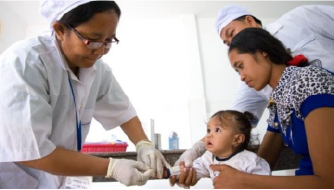Opinion: PEPFAR and the Global Fund must improve care for HIV-positive children
Jan 27, 2021
Maureen Milanga and Alexandra Volgina

On World AIDS Day last month, a breakthrough was announced for children with HIV in low-income countries. The integrase inhibitor dolutegravir, an antiretroviral medicine recommended for first-line treatment, is being manufactured in a 10- milligram formulation that can be given easily to infants weighing less than 20 kilograms. It dissolves in liquid and tastes like strawberries, and the price negotiated with generic drug companies Viatris and Macleods Pharmaceuticals is competitive.
Following this announcement, the Global Fund to Fight AIDS, Tuberculosis and Malaria; the United States President's Emergency Plan for AIDS Relief; and others pledged to support “rapid transition plans” to dolutegravir-based treatment. This marks the first time very young children with HIV will have access to this recommended regimen, already widely used by adults.
Extremely poor HIV treatment coverage for children is a public health crisis. In 2019, only 53% of children living with HIV were on antiretroviral treatment, compared with 68% of adults with HIV.
Children also account for a disproportionate number of AIDS deaths. In 2019, kids were only 4.7% of the 38 million people living with HIV worldwide but accounted for 13.8% of all AIDS deaths. When children infected with HIV in utero or perinatally do not have treatment, half will die before their second birthday, and one-third will die before their first birthday, so this easy-to-take pediatric formulation is ideal for the period when mortality spikes for infants infected with HIV.
A positive development like this comes with a galling question: Infancy is when kids are at the greatest risk of death, so why has it taken decades for the youngest children in the countries with the highest rates of HIV to get a chance to benefit from the same powerful regimens already available for adults and adolescents?
Children with HIV have rarely been the focus of pharmaceutical companies or the biggest funders of the global AIDS response. Children with HIV represent a relatively small population, and the complex needs of their caregivers make it easy for overwhelmed health systems to pass them over. Because their numbers are small, their consistently poor clinical outcomes are typically downplayed when countries report overall progress against national treatment coverage targets.
Access to pediatric dolutegravir alone is not the game changer that children with HIV need.
Chronic neglect of the needs of children with HIV does not start with treatment; it starts with diagnosis. Children perinatally exposed to HIV need to know urgently if they are HIV-positive.
But ordinary pediatric HIV testing — called conventional early infant diagnosis, or EID — is fraught with long waiting times for caregivers to receive results. By 2 months of age, only an estimated 59% of HIV-exposed infants have been tested globally. In a 2018 assessment in nine sub-Saharan African countries, only 50% of HIV-exposed infants were tested within two months of birth, and of those tested, only 15% had results returned to a caregiver within 30 days.
By contrast, “point-of-care” EID, or POC EID, a technology piloted in 2016, allows for immediate HIV diagnosis and linkage to treatment, similar to rapid HIV testing for adults. Scientific evidence has repeatedly shown that POC EID holds vast benefits compared with conventional EID in timely linkage to pediatric treatment, reducing waiting times for caregivers, and reducing loss to follow-up among children and their families.
Despite the critical importance of POC EID, the World Health Organization is still providing only a “conditional” rather than a “strong” recommendation that countries adopt POC EID in their HIV programs. It is our view that this recommendation by WHO is out-of-date. It is unacceptable and must be changed immediately.
HIV programs in countries with the highest burden of pediatric HIV still have not rolled out POC EID, promising instead to make conventional EID more efficient. But this strategy simply has not worked, and their years of foot- dragging have been a disaster for HIV-exposed infants.
According to data compiled by the HIV Policy Lab, 43% of countries — including 25% of PEPFAR priority countries — do not include POC EID in their national guidelines. Of the PEPFAR countries that do include POC EID, UNAIDS reports that only a handful have implemented it countrywide.
Over a year ago, on International Human Rights Day 2019, the Health Global Access Project, or Health GAP, launched its Kigali Declaration to highlight and correct the shameful inequities that are resulting in the preventable suffering and death of children with HIV. Pediatric dolutegravir holds the promise of taking us a step closer to ending pediatric AIDS.
According to our research, only 16% of all countries, and only 39% of PEPFAR countries, have testing and treatment policies that are fully aligned with WHO recommendations for HIV-positive and HIV-exposed infants. Three priority steps must be taken now to halt the second-class care that children with HIV face.
First, all countries must move urgently to adopt the new formulation of dolutegravir and eliminate suboptimal treatment, beyond the six countries — Benin, Kenya, Malawi, Nigeria, Uganda, and Zimbabwe — initially designated for the first wave of implementation.
Second, countries should immediately implement national POC EID access so all infants exposed to HIV can benefit from rapid diagnosis. Evaluations of POC EID point to its superiority in terms of rapid pediatric antiretroviral therapy initiation compared with conventional EID. It is our view that WHO’s recommendation is no longer accurate and should be immediately changed with interim technical guidance.
Third, better treatment and POC EID are necessary but not sufficient — increased funding is also needed for treatment literacy and a complement of community-led supportive services for caregivers, many of whom are HIV-positive and too often lost to clinical care themselves.
Anecdotal reports of serious pediatric treatment disruptions driven by COVID-19 restrictions point to the immediate need for interventions from PEPFAR and the Global Fund that buffer pediatric service delivery from coronavirus harms. Medical interventions will fail without these components.
The rollout of pediatric dolutegravir-based combinations and POC EID platforms should be costed, including the machines, reagents, and health worker training. And those budgets should be funded through Global Fund reprogramming and PEPFAR country operational plan reallocation now — during implementation of current programs — and for PEPFAR’s 2021 country operational plans and 2022 fiscal year.
Children’s lives and the lives of their caregivers must become a priority that is reflected through the budgets and policy agendas of PEPFAR, the Global Fund, and national governments. Our children are dying. The world must wake up and treat this as the emergency that it is.
